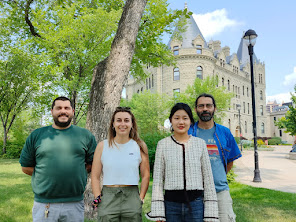Our study focuses on tree defoliation due to the feeding of cankerworm.
In fact, the cankerworms appear in early spring, at the same time as the young tree shoots, and start feeding from then on.
Cankerworms could have serious consequences for trees, but unlike certain species such as processionary caterpillars (Thaumetopoea pityocampa), they pose no threat to humans or animals.
🎯 The goals 🎯
The goals of our study are :
- To determine the typical levels of leaf damage on two of the most common tree species due to the feeding action of cankerworms and other common caterpillars.
- Compare these levels with historical Records.
- Determine if the level of leaf damage is related to the availability of natural enemies of the caterpillars.
📋 The fieldwork 📋
The first part of the fieldwork is to locate the site. To do this, we use Google Maps and Google Earth to visualize the streets where the trees we are looking for are located: elms and ashes.
We are also preparing the blank data sheets we will use to write the data.
The second part of the work consists in going out into the field to take a few measurements on the trees and collect leaf samples.
We take these measurements:
- Tree diameter
- Distance to the nearest-neighbor
- Crown condition
- Number of potential predators in the area
Tree diameter
To measure the tree diameter we use a diameter tape. We place our arms and the tape so that we are at about 1m50 from the ground.
Distance to the nearest-neighbor
We then measure the distance between the tree we are studying and its nearest neighbor. When the nearest tree is the same species we only take this measurement and if it's another species, we take this measurement and the distance to the nearest tree of the same species.
To measure this distance, we use a 50 m tape.
Crown condition
To assess the crown condition, we look at six different branches on the same tree and we estimate the condition with a scale that we have already created.
Scale:
Predators
To observe potential predators we look at the surroundings of the tree and write down the individuals we can see. We also use binoculars to identify better the species.
We proceed at a 10 min by 10 min observation to do the measurements.
The main cankerworms predators are :
- Birds
- Wasps
- Bumblebees
- Hornets
Collecting samples
On the field, we also have to collect leaves samples. To do that, we use an 8 m-long pole pruner, this tool must be used carefully with two people when all extensions are added. One person holds the pole pruner while the other one pulls the rope to cut the branch.
🔬 The lab work 🔬
The lab work consists on scanning the leaves. To do this, we use image analysis software (WinFolia) which provides us the data from the leaves (perimeter, area, length, width, etc.).





No comments:
Post a Comment